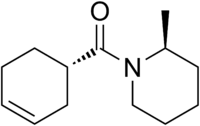SS220
 | |
| Names | |
|---|---|
| Other names
*(1S,2'S)-Methylpiperidinyl-3-cyclohexen- 1-carboxamid
| |
| Identifiers | |
| 298207-27-9 | |
| Properties | |
| C13H21NO | |
| Molar mass | 207,31 g·mol−1 |
| Except where noted otherwise, data is given for materials in their standard state (at 25 °C (77 °F), 100 kPa) | |
| Infobox references | |
SS220 is an insect repellent with a broad range of efficacy.
It was developed in 2002 at the Chemicals Affecting Insect Behavior Laboratory of the United States Department of Agriculture[1] and has been found to "exert repellent and deterrent effects upon the behavior of mosquitoes and sand flies."[2] In the field, it has been shown to provide significantly better protection than DEET.[3]
See also
References
- ↑ J. A. Klun, A. Khrimian, A. Margaryan, M. Kramer, M. Debboun: Synthesis and Repellent Efficacy of a New Chiral Piperidine Analog: Comparison with Deet and Bayrepel Activity in Human-Volunteer Laboratory Assays Against Aedes aegypti and Anopheles stephensi. Journal of Medical Entomology, 40(3), pp. 293–299, PMID 12943107
- ↑ Jerome A. Klun, Ashot Khrimian, Mustapha Debbound (2006): "Repellent and Deterrent Effects of SS220, Picaridin, and Deet Suppress Human Blood Feeding by Aedes aegypti, Anopheles stephensi, and Phlebotomus papatasi. (PDF) Journal of Medical Entomology 43(1), pp. 34–39.
- ↑ Stephen P. Frances, Donna O. Mackenzie, Jerome A. Klun, and Mustapha Debboun (2009): "Laboratory and Field Evaluation of SS220 and Deet Against Mosquitoes in Queensland, Australia". (PDF) Journal of the American Mosquito Control Association, 25(2), pp. 174–178.
- ↑ Leahy, Stephen (June 27, 2003). "Building a Better Bug Beater". Wired News.